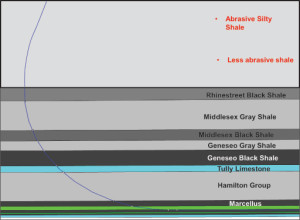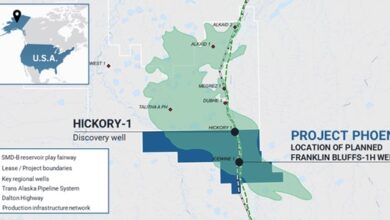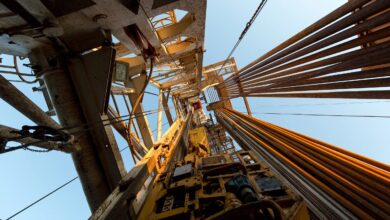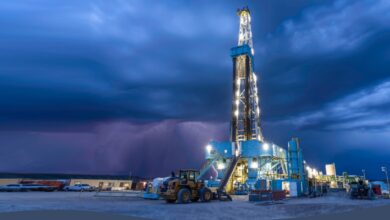High-build RSS drills consistent, in-zone wells in Marcellus
Near-bit inclination, optimized bits allow curve, lateral sections to be drilled in one run
By Anthony Jones, Denise Livingston, Andrew Serdy, Sandeep Janwadkar, Baker Hughes Inc; Toby Rice and Derek Rice, Rice Energy

The Marcellus Shale is emerging as one of the world’s most prolific and fastest-growing shale gas plays. Multipad horizontal drilling, tight lease boundaries, complex well profiles, anti-collision considerations and critical landing zones make this a challenging environment.
To overcome these challenges, an operator and a service provider used a high build-rate rotary steerable system (RSS) to drill multiple complex 3D well profiles from a single pad. The approach included optimizing the bit for the RSS, enabling the curve and lateral intervals to be drilled in one run. The average number of drilling days per horizontal curve and lateral well were reduced by 51.9%. With more predictable drilling costs and improved well planning measures, the operator drilled 16 wells in the Marcellus.
Marcellus drilling challenges

Figure 2: Higher build rates provided by the new rotary steerable system enabled one-run-drilled curves and laterals and increased reservoir exposure.
The operator began exploring Pennsylvania’s natural resources in 2007, with most drilling activity in the counties of Washington and Greene, where wet gas is found.

Figure 3: With the new high build-up-rate rotary steerable system, the entire bottomhole assembly is shipped to the rig in one piece. This simplifies transportation logistics and avoids breaking electronic connections at the rig site.
Average Marcellus horizontal well plans require curve buildup rates between 8°/100 ft and 10°/100 ft. Traditional bent-angle mud motors and PDC bits present specific drilling challenges:
• Inconsistent curve buildup rates (BUR) requiring increased bent-angle mud motor settings;
• Higher bend-angle mud motor settings limit the drill string RPM due to fatigue potential and reduces the effective rate of penetration (ROP);
• Diverse interbedded formation groups with differently reacting formations (with respect to BUR);
• Fast-changing formation consistencies make PDC toolfaces difficult to control and conform to well plan;
• Excessive sliding to achieve well plan;
• Potentially tortuous well profiles, which affect weight transfer with increased torque and drag;
• Increased trips between curve and lateral well profile sections to adjust conventional mud motors to achieve the required well plan trajectory;
• Critical landing targets for optimal reservoir placement and avoidance of high unconfined compressive strength (UCS) formations that lie below the Marcellus Shale (Onondaga limestone);
• Tightly spaced on surface multiwell pads create considerable anti-collision considerations; and
• Tight leasing units and boundaries.
Figure 1 shows a typical geological crossplot of southwest Pennsylvania formation tops and their commonly known names. It shows the difficulties encountered when building a curve for a horizontal well profile in the Marcellus. Directional drilling with conventional bent-angle mud motors typically have an inclination and azimuth directional sensor more than 60 ft away from the bit. This makes depicting motor yields for slide intervals and forward drilling projections difficult to anticipate because the formation characteristics change quickly.

Configuring bit technology to complement the high-build RSS was important to realize its potential. The dull analysis for the initial bit was noted, including signs of severe abrasive wear to the shoulder and drill bit cutting structure gauge (Figure 4, left top). The excessive wear was originally thought to have resulted from reaming through sand formations and tight spots in the vertical section. However, heavy shoulder and gauge cutter wear were also observed on stronger, more durable bit designs when no reaming was required (Figure 5, right top). Figure 6 (left bottom): Dull condition after the first run, which used the same drilling parameters as offset wells, was improved compared with offset dulls. However, signs of wear and damage to the cutting structure in the bit’s shoulder were still evident. Figure 7 (right bottom): After being run with optimized parameters, by increasing the WOB and decreasing ROP to allow the RSS to function, the dull showed no signs of wear or damage to the shoulder or gauge area of the cutting structure.
One key piece of the high-build RSS (HBRSS) is near-bit inclination, which enables directional drillers to easily sense bit inclination and rapidly adjust drilling parameters while on bottom.
Prior to the HBRSS, conventional high-bend angle mud motors were used to build the wellbore curve profile; typically, either a lower-bend angle mud motor or an RSS would have been chosen to drill a horizontal lateral well. Figure 2 shows the benefits of higher build rates, which enabled one-run-drilled curve and laterals.
Another challenge in the Marcellus is encountered in the lateral as a tight target window requires the wellbore to be delivered through geosteering while drilling. To help the operator keep the well path in the critical zone of interest, the drilling assembly had to hold inclination targets steady as defined by the geosteering team.
In tight or optimal target windows with a conventional system, the bit may exit the target prior to the gamma formation evaluation sensor noting a difference. However, HBRSS technology enables the gamma formation evaluation curve sensor to be closer to the bit. Formation trends can be observed more quickly, along with ability to rapidly adjust steering requirements while drilling ahead on-bottom.
HBRSS development
In 2011, the service provider began field testing its newly developed HBRSS, which can build up to 15°/100 ft in environments including the Eagle Ford, Granite Wash, Cana Woodford, Fayetteville, Utica and Marcellus. In 2012, the tool was commercialized and by early 2013 had accumulated more than 3 million ft drilled and 60,000 total circulation hours.

With this technology, the entire bottomhole assembly (BHA) (Figure 3) is shipped to the rig in one piece, thus avoiding breaking sensitive electronic connections at the rig site and simplifying transportation logistics. The system consists of an application-specific drill bit, a stabilized steering unit with near-bit inclination and vibration sensors, a flexible probe with gamma, directional and vibration (lateral, axial and stick-slip) sensors, and a pulser/power module.
The steering unit comprises a downhole closed-loop system with three expandable pads on a short steering sleeve near the bit. The slow rotating sleeve reduces the steering action from drill string rotation,

which becomes insensitive to stick-slip. A smooth, continuous steering adjustment leads to a precise wellbore, minimizing backreaming time

and improving completion operations. The system can be programmed
downhole to drill a controlled lateral after completing the curve section, all in one run.
In addition to the gamma, which allows for better reservoir navigation closer to the bit and measurement-while-drilling services, with an optional battery for flow-off surveys for motor-assisted BHAs, a flexible probe provides drilling dynamics and flexibility for higher doglegs.
The turbine-driven pulser/power module generates power for all BHA functions and uses mud-pulse telemetry; the turbine and pulser were optimized for plugging resistance and uninterrupted function in high lost circulation material contents in laboratory and field tests.
To achieve predictable results, the HBRSS was designed with consideration of the entire system, including the BHA, drill bit, drill string and drilling fluid. The HBRSS has delivered buildup rates greater than 17°/100 ft in field tests. The well

profiles discussed in this article required a BUR of 8° to 10°/100 ft.
With high BURs under continuous rotation, material fatigue from cyclic bending is a concern. Extensive finite element analysis simulations were conducted to ensure long part lives. Further, because high build rates require a flexible BHA, the steering actuators and control system must provide increased agility to tightly control trajectory. The system includes improved control electronics and algorithms, as well as increased steering forces and steering pad travel, to compensate for formation trends and borehole irregularities.

In long tangent sections, low tortuosity is needed to optimize ROP and hole cleaning and improve the efficiency of casing operations and plug-and-perf or sliding-sleeve fracturing completions. In vertical sections, a

precise, straight wellbore is critical for collision avoidance in pad applications. The new system provides an oriented kickoff from vertical (or another inclination) to ensure the desired kickoff direction is met without corrections or increasing collision risk.
While most steering adjustments are automated in the downhole system, the driller can send changes via a computerized downlink system. For example, a target inclination and maximum force equating to a desired build rate can be sent from the surface, and the tool then steers toward the inclination and maintains it, compensating for formation tendencies without further interaction from the surface. The system can further be deployed with a mud motor and a battery to enable flow-off surveys. All functions are accessible via remote operations centers.
Drill bit design
Configuring bit technology to complement the HBRSS was important to realize its full potential. This project used a six-bladed bit design with a 19-mm primary cutting structure and 16-mm backup cutters. Prior system-specific bit features were developed by assembling a summary of the area, geology, risks and objectives. Previous bit design objectives for the RSS in the Marcellus included bit stability and resistance to vibrations, improved hole quality, maximum steerability and BURs, improved ROP and optimized hydraulic cleaning action. The new six-bladed design incorporated these features, plus increased bit durability and preservation of the sharpness of the cutting structure through a highly interbedded and abrasive silty-shale formation.
The current design’s dull analysis was taken into account and noted that there were signs of severe abrasive wear to the shoulder and drill bit cutting structure gauge (Figure 4). The excessive wear was originally thought to be a result of the need to ream through short intervals of sand formations and through tight spots in the vertical section while tripping to bottom with the RSS because of hole swelling and BHA stiffness. However, heavy shoulder and gauge cutter wear were also observed on stronger, more durable bit designs when no reaming was required (Figure 5). The BHA only drilled through a relatively soft formation known as the Middlesex Grey Shale before reaching the curve kickoff point.
The excessive wear to the shoulder of the cutting structure resulted in two main concerns. The first, and most detrimental, concern was a low BUR in the curve section. This was a result of the damage to the cutting structure in the bit shoulder, which is critical in maintaining adequate side-cutting. The RSS tool’s side force acts directly upon the cutting structure in the drill bit’s shoulder. If that cutting structure is worn or damaged, a loss in side-cutting ability and a reduction in BUR potential are noticed.
The second concern was a loss of ROP and drilling efficiency because the shoulder area also has the highest cutter work rate, which is a measurement of the total volume of rock removed per cutter. The shoulder cutters rotate on a larger path and remove the majority of rock. If the shoulder becomes damaged or worn, the efficiency and ROP suffer proportionally.
As a result of the dull analysis, focus was placed on optimizing bit durability and drilling parameter optimization.
Application-specific BIT
To maximize durability, the blade count was increased from five blades to six to increase the diamond volume present in the cutting structure. The cutting structure was changed from a 16-mm cutter to a deep-leached, abrasion-resistant 19-mm polished cutter. These cutters were much more abrasion-resistant in lab testing. A larger cutter also maximized cutter exposure, providing higher top-end ROP in soft shale formations in the curve and lateral sections.
The mirror polish applied to these cutters reduces cutter surface friction so cuttings slide off easily. The result is increased hydraulic cleaning efficiency and ROP. Polished 16-mm backup cutters were also included in the design to increase diamond volume and cutting structure durability.
The operator’s typical run parameters were also included in the software model. Figure 6 shows the dull after the first run, using the same drilling parameters as offset wells. The dull condition was improved compared with offset dulls, but signs of wear and damage to the cutting structure in the bit’s shoulder were still evident.
Formation analysis

To prevent premature damage or wear to the drill bit shoulder, an analysis of the formations encountered had to be conducted to determine exactly where in the well path the damage was occurring. The entire section length was drilled in shale or silt formations, with the exception of a single limestone formation called the Tully Limestone, near the curve kickoff point. A normal shale formation is physically incapable of producing the abrasive wear to the cutting structure of the bits observed in the dull analysis because shale is inherently non-abrasive.
Offset well analysis indicated some bits were being pulled with heavy shoulder wear before encountering the Tully Limestone. This data shifted the investigation focus to shale formations above the Tully. Analysis found the Middlesex Grey Shale was actually tightly interbedded shale and silt layers; the layers were so tightly interbedded that the silt had permeated into the shale formations, making it impossible to differentiate between the two via the gamma track while drilling. An in-depth mud sample analysis was needed to identify the silt, which was found to be highly abrasive with signs of quartzite.
Data from offset wells and dull analysis indicated the abrasive silt in the Middlesex Grey Shale formation was causing premature wear on the drill bits’ cutting structure.
Optimized drilling parameters
After the formation causing the bit damage was identified, the drilling parameters were changed to mitigate and prevent the issue. Previous run parameters included high RPMs combined with low weight on bit (WOB). The high RPMs and low ROPs resulted in a shallow cut depth, and therefore, a small percentage of the cutting structure engaged the formation, and bit whirl was encountered.
To fully engage the cutting structure and stabilize the bit while drilling, the WOB was increased and the RPMs decreased to levels that allowed the RSS to function properly while mitigating bit wear. The increased depth of cut stabilized the drill bit, preventing premature wear to the cutting structure. Figure 7 shows the dull bit after being run with optimized parameters through the Middlesex Shale. The dull shows no signs of wear or damage to the shoulder or gauge area of the cutting structure.
Implementation, results to improve consistency

Alignment of the HBRSS and the drill bit as a total system was a key element in the project’s success. Matching the drill bit to the geological environment and to the specific application that it is placed into service with the RSS minimized altered variables and ultimately provided consistent performance.
The project had significant impact on the operator’s drilling program. All data was gathered from horizontal multipad drilling operations and is an average of 2D, 3D and negative vertical section well profiles. All performance charts evaluate only the curve and lateral sections, or just from the curve kickoff point to the lateral total depth (TD). Figure 8 shows the HBRSS enabled the operator to tackle longer well profiles, ultimately expanding production potential, and Figure 9 shows that drilling days per well was reduced even with overall longer laterals.
Overall well penetration rates also improved. Figures 10, 11 and 12 present the depths drilled per day for the curve and lateral intervals. The average HBRSS drilled 435 ft/day more than conventional tools in the curve section, a 165% improvement. In the lateral interval, on average, the system drilled 555 ft/day more, an average 62% gain.
The combined curve and lateral drilled footage per day (Figure 12) increased 638.3 ft on average for a combined performance enhancement of 136%. Trends in the day-versus-depth plot (Figure 13) reinforce the trend in the footage-per-day plots. All wells in the days-versus-depth plot show data trends from the curve kickoff point to the lateral TD point. The red lines show conventional tool deployments and the blue lines show HBRSS deployments. The latter on the left side of the plot show a trend of drilling deeper more quickly and more consistently than with conventional tool deployments. The averages between the HBRSS-drilled curve and lateral intervals (compared with conventional tool deployments) indicate 8.2 drilling days were saved.
Wells can be fast with high penetration rates, but if not kept in the optimal target reservoir, the overall economics of the wells decline despite wells being drilled quickly.
Figures 14 and 15 represent two wells drilled from the same horizontal multi-well pad. Both wells are shown in 3D through a 10-power zoom. The red well was drilled with a conventional motor, and it can be noted the imposed tortuosity from geosteering verses the HBRSS tool. The red well stayed within a 10-ft target interval for 4,500 ft, whereas the blue well drilled with the HBRSS stayed within a 3-ft target interval for 6,000 ft.
A plot of lateral inclination as drilled from the wellbore surveys versus the operator’s desired target inclination (Figure 16) was prepared in the form of a quality control chart. The red lines show the operator’s on-site geologists request for desired target inclination, and the blue dots are the HBRSS actual survey inclination points within the wellbore. The left side of the plot is a scale from 88° of inclination to 92° in 0.2° intervals. The plot shows that actual surveys average within 0.1° of the desired inclination and consistent performance.
As of February 2013, the operator has been able to effectively show repeatable performance with lateral lengths to 9,600 ft. The operator is planning lateral lengths in excess of 10,000 ft during its 2013 drilling program because of the repeatable performance.
Figure 17 compares effective lateral length to drilling days of both the curve and lateral. The data output in the scatter plot shows the trend of the HBRSS tool as all wells are tightly knit within the highlighted blue circle on the plot. Because the data shows a tighter knit trend, a linear trend line can be drawn though the HBRSS wells, allowing the operator to better predict well costs and exposed drilling days per well. This is a substantial improvement over the inconsistencies of the red dots.
With the operator able to predict its exposed drilling costs per lateral length, financial planning and budgeting measures are better controlled.
Conclusions
Challenges of drilling horizontal wells in the Marcellus Shale were overcome through teamwork and for the specific drilling environment. To maximize drilling efficiencies, variables were consistent and controlled. The HBRSS enabled the drilling system to fit the operator’s application and goals using system approach incorporating near-bit inclination and close-proximity gamma formation evaluation curves. Collaboration between the operator and service provider led to one-run curve and lateral deployments.
Ultimately, the quality and quantity of wells drilled were increased, and the resulting drilling performance and data enabled the operator to predict associated drilling costs, drill longer and more difficult well profiles, and deliver wells more effectively in-zone to improve potential well production characteristics.
This article is based on a presentation at the 2013 AADE National Technical Conference & Exhibition, Oklahoma City, Okla., 26-27 February.
Acknowledgments
The authors would like to thank the management of Baker
Hughes and Rice Energy for permission to publish this paper.
References
1. Hummes, O., Bond, P., Jones, A., Symons, W., Bishop, M., Serdy, A., Pokrovsky, S., Polito, N.. “Using Advanced Drilling Technology to Enable Well Factory Concept in the Marcellus Shale”. IADC/SPE 151466, IADC/SPE Drilling Conference and Exhibition, San Diego, California, 6-8 March, 2012.
2. Hummes, O., Janwadkar, S., Powers, J., Bond, P., Anderson, M., Chesher, S., Paugh, W., Wiggers, C., Roberts, G., Schmidt, S., Hildebrand, J.. “Evolution of High Build-Rate RSS Changes the Approach to Unconventional Oil and Gas Drilling”. SPE 147455, SPE Annual Technical Conference and Exhibition, Denver, Colorado, 30 October – 2 November, 2011.
3. Stevens, P. “The ‘Shale Gas Revolution’: Developments and Changes”. Energy, Environment and Resources, EERG BP 2012/04, August 2012. http://www.chathamhouse.org/sites/default/files/public/Research/Energy,%20Environment%20and%20Development/bp0812_stevens.pdf
4. US Energy Information Administration (EIA), “Horizontal drilling boots Pennsylvania’s natural gas production”. 23 May 2012.
5. US Energy Information Administration (EIA), “2012 Annual Energy Outlook”. 2012.
6. US Energy Information Administration (EIA), “2013 Annual Energy Outlook Early Release”. 2013.
7. US Energy Information Administration (EIA), “Review of Emerging Resources: US Shale Gas and Shale Oil Plays”. 8 July 2011.
8. US Energy Information Administration (EIA), “Geology and technology drive estimates of technically recoverable resources”. 20 July 2012.
9. US Energy Information Administration (EIA), “US Crude Oil, Natural Gas, and Natural Gas Liquids Proved Reserves, 2010”. US Department of Energy, Washington, DC 20585, August 2012.
10. USGS. “Assessment of Undiscovered Oil and Gas Resources of Devonian Marcellus Shale of the Appalachian Basin Province”. National Assessment of Oil and Gas, 2011.
11. USGS. “US Geological Survey Information Relevant to US Geological Survey Assessment of the Middle Devonian Marcellus Shale of the Appalachian Basin Province, 2011”. Open File Report 2011-1298. US Department of the Interior and US Geological Survey, Reston, Virginia, 2011.
12. Pennsylvania Department of Conservation and Natural Resources Bureau of Topographic and Geologic Survey, “Oil and Gas Fields of Pennsylvania – Map 10”. 4th Edition, 2200-MP- DCNR0854, 2007.
13. US Department of Energy, Office of Fossil Energy, National Energy Technology Laboratory, “Modern Shale Gas, Development in the United States: A Primer”. April, 2009 Energy Technology Laboratory, “Modern Shale Gas, Development




